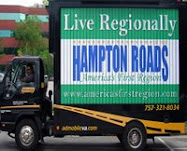| by Mike McGinnis, Executive Director Virginia Modeling, Analysis and Simulation Center |  Click here for the Presentation |
Significant economic development and business growth opportunities exist for the Commonwealth of Virginia and Hampton Roads region. Several notable growth areas for our region are modeling and simulation, defense and logistics.
Defense has long been the economic anchor for the region with Hampton Roads being home to four four-star headquarters including the largest navy base in the world. During the past decade, the region has emerged as a national hub for modeling and simulation research and development. There are over ten modeling and simulation research centers currently located in the Hampton Roads region with the U.S. Joint Forces Command being the government anchor for this emerging industry.
On the academic side, the Virginia Modeling, Analysis and Simulation Center (VMASC) of Old Dominion University has emerged as one of the top M&S centers in the United States. ODU is one of only three universities to offer modeling and simulation graduate degrees.
The sector that holds the greatest growth potential, however, is transportation, distribution and warehousing. In this sector, the Hampton Roads and Crater regions are strategically positioned to emerge as a nationally prominent mid-Atlantic hub for logistics, transportation, distribution, and warehousing. Over 50 top companies have already established major distribution centers in Virginia to take advantage of the Commonwealth’s strategic location that puts them within 750 miles of two-thirds of the U.S. population.
In addition to river and seaports, airports, interstate roads and rail networks available in Hampton Roads and Crater, the two regions also offer ample open ‘green space’ that is key to regional economic growth and to attracting new business and businesses.
Virginia features extensive transportation capabilities and capacities. The Commonwealth is served by two major airports in Northern Virginia and key regional airports in Richmond, Newport News and Norfolk.
A major expansion of the Hampton Roads’ port was completed in 2008 with the opening of the APM Terminal. The next expansion phase will be the $2 billion Craney Island Marine Terminal that, once operational in 2017, will handle 2 to 3 million cargo containers annually.
The Hampton Roads-Crater (HR-C) region features a robust network of interstate and primary roads, and major rail networks that will be further enhanced by the Heartland Corridor Rail Project connecting the region directly with the Midwest.
By 2011, Fort Lee will be home to three major Army service support branches: Transportation, Ordnance and Quartermaster. Anchored by Fort Lee expansion and its emergence as the center for DoD logistics, the Crater Region is well positioned to expand as a hub for logistics in the decade ahead.
For the Commonwealth to capitalize on conditions in Hampton Roads-Crater and to achieve national prominence as a mid-Atlantic hub in transportation and distribution will require an articulate vision and strategy; support from government, industry, and elected officials; and a regional strategy for funding, job creation, energy requirements and workforce development. Growth of this magnitude demands cooperation, coordination and synchronization of resources across the municipalities and counties that make up the Hampton Roads-Crater region.
Modeling and simulation can help with this growth by representing and benchmarking current capabilities as they exist today in an M&S environment will give federal, state and regional leaders and stakeholders a common framework for envisioning a growth strategy and plans for the Hampton Roads-Crater region as a strategic mid-Atlantic hub for logistics, transportation, distribution and warehousing.
The study team will, in turn, take the regional growth plans and turn them into scenarios in the M&S environment. Through visualization and metrics, the M&S virtual environment will provide stakeholders with a common framework for testing, analyzing and debating the growth scenarios from various perspectives – local, regional, state and federal – government, military, industry, and academic – that are important to the constituencies of the region, the Commonwealth of Virginia and beyond.































No comments:
Post a Comment